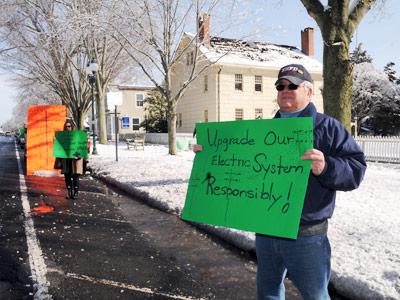Farmland in Name Only?
Farmland in Name Only?
With a lighter than normal agenda on Jan. 15, Reed Jones, the East Hampton Town Planning Board’s chairman, took the open time to launch a discussion on the town’s agricultural policy, as applied by his board.
Ian Calder-Piedmonte, himself a farmer, led the discussion. He has expressed concern over the past two years about the growing number of subdivisions with agricultural land being set aside in name only. The problem, he told fellow board members, is that the wealthy buyers of large properties in these new subdivisions, which also have large agricultural reserves, simply look at the reserved land as a big lawn. “You have to try a little harder than say, ‘I’m going to buy a big house and have this huge lawn,’ ” he said.
It was important, he said, to try to get owners to see that the land is actively farmed. “Now, that farmland is lost if they can’t find a tenant, or somebody to do the farming.”
Currently, under the town’s zoning code, land set aside as an agricultural reserve cannot be used for any other purpose, say as a croquet court, though what constitutes an agricultural use is fairly broad, under the code. It includes “the production or raising of field crops, vegetables, fruits, trees, horticultural specialties, flowers, livestock (including cattle, sheep, goats, horses, and poultry) and livestock products and other ordinary farm products.”
Bob Schaefer pointed out that many crops in the Midwest are subsidized. “What if you’re farming and you can’t find anybody to buy your product?” he asked.
“Perhaps it is growing cover crop,” Mr. Calder-Piedmonte responded. “The details here are going to be a little tricky but we can’t just throw up our hands,” he said.
Patrick Schutte questioned how it would be possible to enforce what is already on the books. “We’re creating 70 percent open space, but we have never had a mechanism that could be enforced. Do we want to have a mechanism where the town can force people to do what they don’t want to do? In my mind, we’re creating agricultural land, but we are not enforcing,” he said. But, he pointed out, the land would always be available for agricultural use, if needed.
“I think our code is stronger than that,” Mr. Calder-Piedmonte countered. An agricultural set-aside “isn’t for open space, it is for farming.” Mr. Calder-Piedmonte also looked back at previous subdivisions, like the recent Estates at Further Lane, a large parcel of beachfront land owned by Ron Baron that includes an agricultural reserve.
Job Potter, a former town councilman who was appointed to the board earlier this month, weighed in on the issue. “The town board would need to grapple with what happens when farmland is abandoned. It is important to distinguish between land that was bought by the town,” he said, and land that was set aside as part of the subdivision process.
The board also discussed suggesting that East Hampton follow Southampton Town’s lead and establish an agricultural advisory committee. Members of the board would be interested citizens from East Hampton, but could also include members from outside organizations, like the Peconic Land Trust.
Mr. Jones promised that the board would continue this dialogue in the coming months. “This is a big topic,” he said. “There are a lot of specifics. It is the board’s intention to keep this open for public comment and input.”
Saunders, Crystal Room
Hearings on new East Hampton headquarters for the Saunders and Associates real estate firm and a site plan for the former Crystal Room property are on the East Hampton Town Planning Board’s schedule for Wednesday at 7 p.m.
Saunders and Associates is looking to give the vacant one-story building at 24-26 Montauk Highway a major makeover, including a second story. The lot to the east of the building would be merged with the western lot to allow for parking. Because the lots are in a limited business overlay district, only 2,000 square feet is to be used for business purposes. The existing building is 3,500 square feet. By combining the lots to provide the required extra parking, the owners are hoping to be able to expand the nonconforming building. Kathryn Santiago, the board’s attorney last year, had advised the board that the developer’s plan was permissible under the town’s zoning code.
However, a new town attorney, Elizabeth Vail, said Monday that the proper person to make that determination is the town’s chief building inspector, Tom Preiato, a point reiterated on Tuesday by the board’s new attorney, John Jilnicki. If Mr. Preiato has not made his determination on the matter by the time of the hearing, the hearing will be kept open to await his decision, Mr. Jilnicki said.
At the former Crystal Room property on Pantigo Road in East Hampton, the owners are proposing six two-story, 1,599-square-foot units, each with a 238-square-foot garage and 350 square feet of decking. According to Richard Whalen, representing the applicant, the estate of Albert Trages, the approximately 1.5-acre property is one of only four lots in the town where multiple residences are permitted by zoning.





